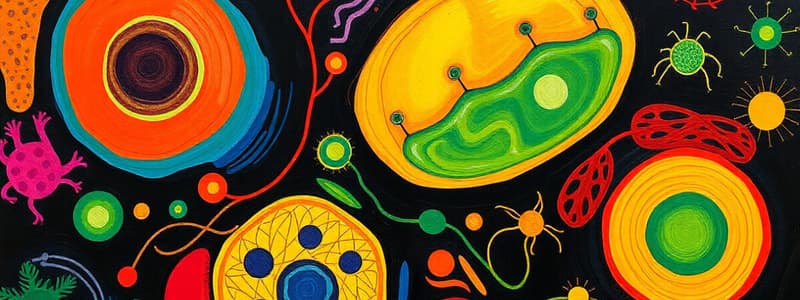Podcast
Questions and Answers
What does the term 'morphology' refer to in biology?
What does the term 'morphology' refer to in biology?
Morphology refers to the study of the shapes and arrangement of parts of organisms to determine their function and development.
How do prokaryotic cells differ from eukaryotic cells?
How do prokaryotic cells differ from eukaryotic cells?
Prokaryotic cells lack a nucleus and membrane-bound organelles, while eukaryotic cells contain a nucleus and organelles enclosed by membranes.
What is the primary characteristic that distinguishes the kingdom Animalia?
What is the primary characteristic that distinguishes the kingdom Animalia?
The kingdom Animalia is characterized by being eukaryotic, multicellular, and heterotrophic.
Explain the concept of homeostasis in biological systems.
Explain the concept of homeostasis in biological systems.
What are the main differences between 'growth' and 'development' in organisms?
What are the main differences between 'growth' and 'development' in organisms?
Identify the main groups of organisms classified as prokaryotes.
Identify the main groups of organisms classified as prokaryotes.
What role does metabolism play in living organisms?
What role does metabolism play in living organisms?
Define adaptation through evolution in terms of population changes.
Define adaptation through evolution in terms of population changes.
What is the main difference between asexual and sexual reproduction?
What is the main difference between asexual and sexual reproduction?
Who first proposed that all cells come from pre-existing cells?
Who first proposed that all cells come from pre-existing cells?
What role do antibodies play in the immune response to a virus?
What role do antibodies play in the immune response to a virus?
How does a cell recognize that a virus has entered its membrane?
How does a cell recognize that a virus has entered its membrane?
What did Anton Van Leeuwenhoek contribute to the field of microscopy?
What did Anton Van Leeuwenhoek contribute to the field of microscopy?
Describe the function of messenger RNA in antibody production.
Describe the function of messenger RNA in antibody production.
What is the significance of the nucleus in the process of antibody formation?
What is the significance of the nucleus in the process of antibody formation?
What was the debate between Mattias Schleiden and Theodore Schwann regarding cells?
What was the debate between Mattias Schleiden and Theodore Schwann regarding cells?
Flashcards are hidden until you start studying
Study Notes
Introduction to Biology
- Biology derives from Greek terms: "Bios" meaning life and "Logos" meaning study.
- Study of living organisms includes fields like morphology, anatomy, physiology, behavior, and distribution.
Morphology
- Examines shapes and arrangements of organism parts to understand their functions and evolutionary history.
- Key term: FORM.
Anatomy
- Investigates the structure of plants and animals.
- Focuses on specific structures, including appearance, components, and functions.
Physiology
- Explores how the human body functions and operates.
Behavior
- Describes changes in organism activity in response to stimuli.
Distribution
- Analyzes spatial relationships among population members within a habitat.
Cell Types
- Bacteria: Prokaryotic, lacking membrane-bound organelles (e.g., E. Coli, Salmonella).
- Archaea: Single-celled with similar structures to bacteria; examples include methanogens, halophiles, and thermophiles.
- Eukaryotes: Contain a nucleus; includes animals, plants, fungi, and protists.
Five Kingdoms
- Animalia: Eukaryotic, multicellular, heterotrophic.
- Plantae: Eukaryotic, multicellular, autotrophic.
- Fungi: Eukaryotic, multi/unicellular, heterotrophic.
- Protista: Eukaryotic, multi/unicellular, auto/heterotrophic.
- Monera: Comprised primarily of prokaryotic organisms.
Hierarchical Biological System
- Structured classification includes domain, kingdom, phylum, class, order, family, genus, and species.
Prokaryotic vs. Eukaryotic Cells
- Prokaryotic: No nucleus or membrane-bound organelles.
- Eukaryotic: Contains a nucleus and membrane-bound organelles.
Characteristics of Organisms
- Adaptation through Evolution: Illustrated in phylogenetic trees; reflects population changes over time.
- Cellular Organization: Composed of cells, the fundamental units of life.
- Growth and Development: Growth is quantitative; development is qualitative.
- Heredity: Transmission of genetic material to offspring.
- Homeostasis: Maintenance of internal balance and equilibrium.
- Metabolism: Encompasses all chemical reactions, including protein synthesis and photosynthesis.
- Reproduction: Involves asexual (one parent) and sexual (two parents) models.
- Response to Stimuli: Organisms detect and respond to environmental changes.
History of Cell Theory
- All organisms composed of cells.
- Cells serve as the basic structural and functional units.
- All cells arise from pre-existing cells.
- Notable figures: Zacharias Jansen (compound microscope), Anton Van Leeuwenhoek (discovered bacteria), Mattias Schleiden (plant cells), Theodore Schwann (animal cells), Rudolf Virchow (cell proliferation).
Cell vs. Virus
- Viruses can infect cells by attaching to cell membranes and entering cells.
- Cells recognize viral entry and utilize special enzymes to neutralize the virus.
- Infected cells create and display viral fragments to alert neighboring cells.
- Neighboring cells produce antibodies to combat the virus.
- The antibody production process begins in the nucleus with DNA instructions, which are transcribed into messenger RNA (mRNA).
- mRNA travels to ribosomes in the endoplasmic reticulum to synthesize antibodies.
- Newly formed antibodies are packaged in the Golgi apparatus for delivery outside the cell.
Studying That Suits You
Use AI to generate personalized quizzes and flashcards to suit your learning preferences.




